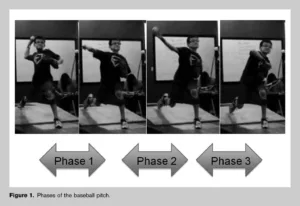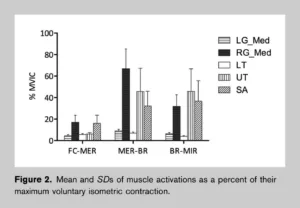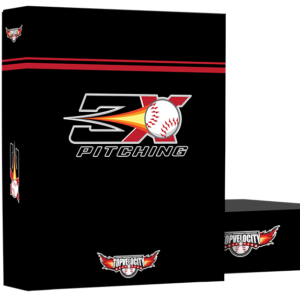 The baseball pitching motion is a highly complex activity involving a synchronized kinetic chain from the toes to the fingertips. Though it may appear that the action is largely involving the upper body, particularly the arm and shoulder, this is not the case. To successfully deconstruct the complexities of baseball pitching, we will look at how the lower and upper extremities interact with one another, with a special emphasis on the pelvic and scapular stabilizers. Understanding these mechanics is not only a scientific undertaking; it is the foundation of athletic performance enhancement and injury avoidance.
The baseball pitching motion is a highly complex activity involving a synchronized kinetic chain from the toes to the fingertips. Though it may appear that the action is largely involving the upper body, particularly the arm and shoulder, this is not the case. To successfully deconstruct the complexities of baseball pitching, we will look at how the lower and upper extremities interact with one another, with a special emphasis on the pelvic and scapular stabilizers. Understanding these mechanics is not only a scientific undertaking; it is the foundation of athletic performance enhancement and injury avoidance.
The Baseball Pitching Motion: Kinetic Chain
Baseball pitching's kinetic chain is a total-body action that effectively utilizes both the upper and lower extremities (Oliver, Weimar, & Plummer, 2015). A pitcher's ability to harness the power generated by the lower body and channel it through a stable core into a powerful and accurate throw is frequently directly associated with their success.
Phase 1: Maximum Shoulder External Rotation to Foot Contact
 The ipsilateral (same-side) leg is critical in situating the pelvis during the first phase of pitching in this study, which lasts from the moment the foot strikes the ground until maximum shoulder external rotation. The gluteus medius muscle is in charge of both hip abduction and internal rotation, which keeps the pelvis level during single-leg support. The gluteus medius is activated at a low-to-moderate level during this phase, which is consistent with previous research.
The ipsilateral (same-side) leg is critical in situating the pelvis during the first phase of pitching in this study, which lasts from the moment the foot strikes the ground until maximum shoulder external rotation. The gluteus medius muscle is in charge of both hip abduction and internal rotation, which keeps the pelvis level during single-leg support. The gluteus medius is activated at a low-to-moderate level during this phase, which is consistent with previous research.
The scapula, in conjunction with the pelvis, must retract successfully to allow the shoulder to be in a posture of approximately 90 degrees of abduction and maximum external rotation. Low activation of scapular stabilizers such as the lower trapezius and serratus anterior shows that experienced players require just little activation to attain the required scapular posture.
Phase 2: The Acceleration Phase
The transition from maximum shoulder external rotation to ball release is where things become interesting. The ipsilateral gluteus medius is highly activated in this case. The upper trapezius and serratus anterior are also activated to varying degrees, indicating a shift from a positional to a more stabilizing role. This phase necessitates more muscular activation due to the increased biomechanical demands.
Phase 3: Release the ball to achieve maximum shoulder internal rotation
The emphasis in the final phase of the pitching motion is on energy dissipation and follow-through. While the stance hip rotates and expands inside, the stride hip must rotate outwardly to maintain the stride foot aligned with home plate. Notably, the scapular stabilizing muscles remain strongly activated, implying that significant scapular protraction is required for successful shoulder acceleration into internal rotation.
Pelvic and Scapular Stability are Critical in the Baseball Pitching Motion
 One important discovery is the link between gluteus medius activation and scapular stabilizers like the lower trapezius and serratus anterior. Their substantial association highlights the significance of pelvic and scapular stability for efficient energy transmission from the lower to upper extremities. Changes in pelvic or hip motions can also disrupt the kinetic chain and increase the risk of injury in baseball pitchers.
One important discovery is the link between gluteus medius activation and scapular stabilizers like the lower trapezius and serratus anterior. Their substantial association highlights the significance of pelvic and scapular stability for efficient energy transmission from the lower to upper extremities. Changes in pelvic or hip motions can also disrupt the kinetic chain and increase the risk of injury in baseball pitchers.
Implications for Training the Baseball Pitching Motion
Understanding these complex biomechanics can help to improve training and rehabilitation regimens. To achieve synchronized efforts in the kinetic chain, specific training should be performed on the gluteus medius, upper trapezius, lower trapezius, and serratus anterior. In the long run, ignoring any of these components may result in inefficiencies or even injuries.
The baseball pitching motion is a kinematic marvel that necessitates a highly synchronized effort on the part of both the bottom and upper extremities. Understanding the role of the pelvic and scapular stabilizers might help you improve your performance and prevent injuries. Athletes can improve their kinetic chain by incorporating these findings into training programs, allowing them to throw harder, more accurately, and with less chance of injury.
Understanding the baseball throwing action via a scientific perspective not only advances the sport, but also lays the framework for generating world-class athletes, reaffirming TopVelocity's dedication to evidence-based practice and training.
The Kinetic Chain Approach of the 3X Pitching Velocity Program
 The 3X Pitching Velocity Program is more than simply another training regimen; it is a comprehensive method to developing elite-level pitchers based on the kinetic chain model. The kinetic chain concept acknowledges that each section of the body is interrelated and that creating force in one place can pass to other segments, resulting in a more forceful and accurate pitch. This program combines biomechanics, functional fitness, and evidence-based sports science to help you maximize your performance on the mound while reducing your risk of injury.
The 3X Pitching Velocity Program is more than simply another training regimen; it is a comprehensive method to developing elite-level pitchers based on the kinetic chain model. The kinetic chain concept acknowledges that each section of the body is interrelated and that creating force in one place can pass to other segments, resulting in a more forceful and accurate pitch. This program combines biomechanics, functional fitness, and evidence-based sports science to help you maximize your performance on the mound while reducing your risk of injury.
In Action: The Kinetic Chain
Our training starts with the legs, which are the foundation of any strong pitch. Lower body strength, which is the starting point in our kinetic chain, is developed through particular strength and conditioning routines. The energy then goes through the hips, core, and lastly to the arm, ending in an explosive pitch. Every workout, drill, and movement pattern in the 3X program is designed to optimize this chain reaction.
Elite Training Components That Work Together in the Baseball Pitching Motion
The 3X Pitching Velocity Program consists of more than just throwing drills. Strength training, speed and agility workouts, mental skill development, and dietary regimens are all included. We think that the best athlete is one who is well-rounded, and with the kinetic chain approach, each component of the program is designed to complement and develop the other. Our program blends cutting-edge sports science research with tried-and-true tactics used by Major League Baseball pitchers.
Injury Prevention: Baseball Pitching Motion
Injury reduction is one of the primary benefits of using a kinetic chain technique. We can distribute the enormous pressures generated during pitching by ensuring that each section of the body is sturdy and works cohesively with the others. This lessens the tension on any single joint or muscle, especially the sensitive elbow and shoulder areas, minimizing the chance of overuse problems.
 Why Attend 3X Velocity Camp?
Why Attend 3X Velocity Camp?
It's one thing to read about kinetic chain training and quite another to put it into practice under the supervision of specialists who have both academic knowledge and practical expertise in the subject. You'll get hands-on instruction, real-time feedback, and actionable insights at our 3X Velocity Camp to accelerate your pitching talents to exceptional levels.
Don't settle for mediocrity when excellence is within grasp. Attend the next 3X Velocity Camp to up your game and secure your future. Register now to take the first step toward becoming an excellent pitcher with a lower chance of injury. Let's smartly alter your game.
For more exclusive content with remote coaching and weekly video analysis checkout TopVelocity Patreon!
Reference:
Oliver, G. D., Weimar, W. H., & Plummer, H. A. (2015). Gluteus medius and scapula muscle activations in youth baseball pitchers. The Journal of Strength & Conditioning Research, 29(6), 1494-1499.


 Why Attend 3X Velocity Camp?
Why Attend 3X Velocity Camp?

